The giant garter snake is a true survivor. This water-loving snake used to live in wetlands that spread across California’s Central Valley. But today, over 90% of those wetlands have been destroyed by agricultural and urban development. Instead of giving up, the giant garter snake adapted, and learned to take advantage of some of the agricultural fields that had replaced their preferred wetlands. One crop in particular provides the kind of habitat most similar to natural wetlands: rice.
With the tadpole-filled, shallow water that they love, the giant garter snake has managed to make a home in the rice fields that thrive in the northern part of the Central Valley. While giant garter snake populations have declined precipitously elsewhere in the state, the snake populations that rely on rice fields are in better condition, and are helping to ensure that the imperiled species does not become extinct.
(story continues below)

Rice has also provided a substitute habitat for other wildlife in the valley that once relied on natural wetlands. In the fall and winter, millions of birds migrating along the Pacific Flyway stop in the Central Valley to feed and rest on the flooded rice fields. Because so little natural wetland habitat remains, these flooded fields are critical for ensuring that there is enough nutrition to support the pintails, long-billed curlews, and other water birds making their epic annual journeys.

While birds and giant garter snakes have come to depend on them, these rice fields can be less of a benefit for fish such as endangered salmon and smelt. The flooding method used to grow rice means the farmers have to take a lot of water out of California’s rivers for their crop to thrive. And when water is scarce (as it often is in California), removing substantial water from our rivers can cause serious problems for fish. Last year, we took so much water out of the Sacramento River that water temperatures spiked and killed almost all of the endangered winter-run Chinook salmon juveniles in the river. This year, it looks like things could be even worse for salmon. Tiny fish in the San Francisco Bay-Delta, like the endangered Delta smelt and the longfin smelt, also need freshwater to flow past the rice farms and into the Bay, and these species can suffer if we take out too much water upstream. Making sure that rice lands are managed to benefit giant garter snakes and migratory birds, but ensuring that they don’t take too much water out of the river, is quite the balancing act!
Adding to the difficulty, we need rice farmers to help make sure their fields truly benefit wildlife. Particularly during drought years, some rice farmers choose to fallow their fields (i.e., not plant rice and leave the ground barren). Instead, they sell their water to farmers in other parts of the state. These “water transfers” are a good way to meet the demand for water by farmers and urban dwellers when there isn’t enough water to go around. But they can also harm birds and giant garter snakes if they aren’t done properly.
We’ve worked hard to advise officials on how to protect giant garter snakes by making sure water transfers don’t result in too many fields being fallowed in areas that are important to the snakes. Unfortunately, the state and federal government have approved a 10-year water transfer program that is likely to drive the species closer to extinction.
Like the giant garter snakes, the birds also need rice farmers to make wildlife-friendly decisions when they plant and harvest their crop. For example, in order to make the leftover grain accessible to birds in the winter, farmers have to flood the rice fields after they’ve harvested the rice. This practice helps the farmers because it causes the leftover rice straw to decompose, leaving the fields ready for planting next year, but it also benefits the birds. There are other ways to remove the straw from rice fields without applying water, however, and if the farmers choose methods other than flooding, the birds will suffer dramatically.
It is no easy task to maintain the delicate balance necessary to safeguard giant garter snakes, migratory birds, and fish. These species live on lands that have been highly altered, with little to no natural habitat remaining. But there are a few ways we can work to make sure these species can thrive into the future. First, we are working to encourage rice farmers to use snake-friendly practices when transferring water, and to flood their fields in the winter to provide food and habitat for birds. We’re also bringing together scientists and policy advocates working on migratory bird and fishery issues so that we can find water-use solutions that benefit both birds and fish. Finally, we’re working to make sure the U.S. Fish and Wildlife Service issues its long-overdue recovery plan for the giant garter snake so that we can continue working towards a brighter future for this wonderfully adaptive creature.



